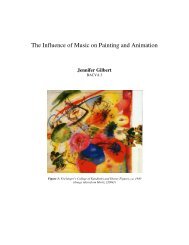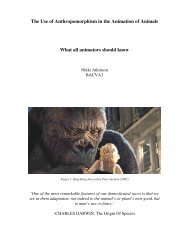An exploration into colour symbolism as used by - National Centre ...
An exploration into colour symbolism as used by - National Centre ...
An exploration into colour symbolism as used by - National Centre ...
You also want an ePaper? Increase the reach of your titles
YUMPU automatically turns print PDFs into web optimized ePapers that Google loves.
Curiously, many of the <strong>as</strong>sociations that we relate to yellow come from those characteristics<br />
<strong>as</strong>signed to green, the <strong>colour</strong> next to which it lies in the spectrum. Green is <strong>as</strong>sociated not<br />
only with symbols of life, but conversely it can also be related to symbols of death and decay.<br />
Foliage, young sprouting plants, and greenery in general all raise connotations with life;<br />
where<strong>as</strong> things like leaf mould and slime remind us of death (Eisenstein 1986).<br />
Green<br />
It is generally believed, <strong>by</strong> the Chinese, Christians and Muslims alike, that the <strong>colour</strong> green is<br />
representative of new life, regeneration and hope. In<br />
“The Arnolfini Wedding” <strong>by</strong> the painter Jan Van Eyck<br />
(see Figure 24), the bride is depicted wearing green to<br />
symbolise her fertility (Freisner 200). The pose in which<br />
she stands, with her dress gathered and held in a way that<br />
makes her abdomen look like it’s swollen, is also<br />
ambiguously suggestive of pregnancy, which further<br />
emph<strong>as</strong>ises this symbolic link.<br />
Figure 24: The Arnolfini Wedding<br />
<strong>by</strong> Jan Van Eyck (1434)<br />
However there are a number of conflicting <strong>as</strong>sociations related to this <strong>colour</strong>, some of which<br />
are considerably less positive. Whilst it may often be seen <strong>as</strong> a <strong>colour</strong> of hope, in some<br />
circumstances green is also seen <strong>as</strong> a symbol of hopelessness and despair. Furthermore, under<br />
certain circumstances in traditional Greek theatre a dark green sea h<strong>as</strong> menacing connotations,<br />
and similarly in Japanese theatre evil or sinister figures were often clothed in blue, one of the<br />
primary additive hues that are combined to make green. Portal stated that green w<strong>as</strong> a<br />
©Laura Dilloway, NCCA 2006 25










